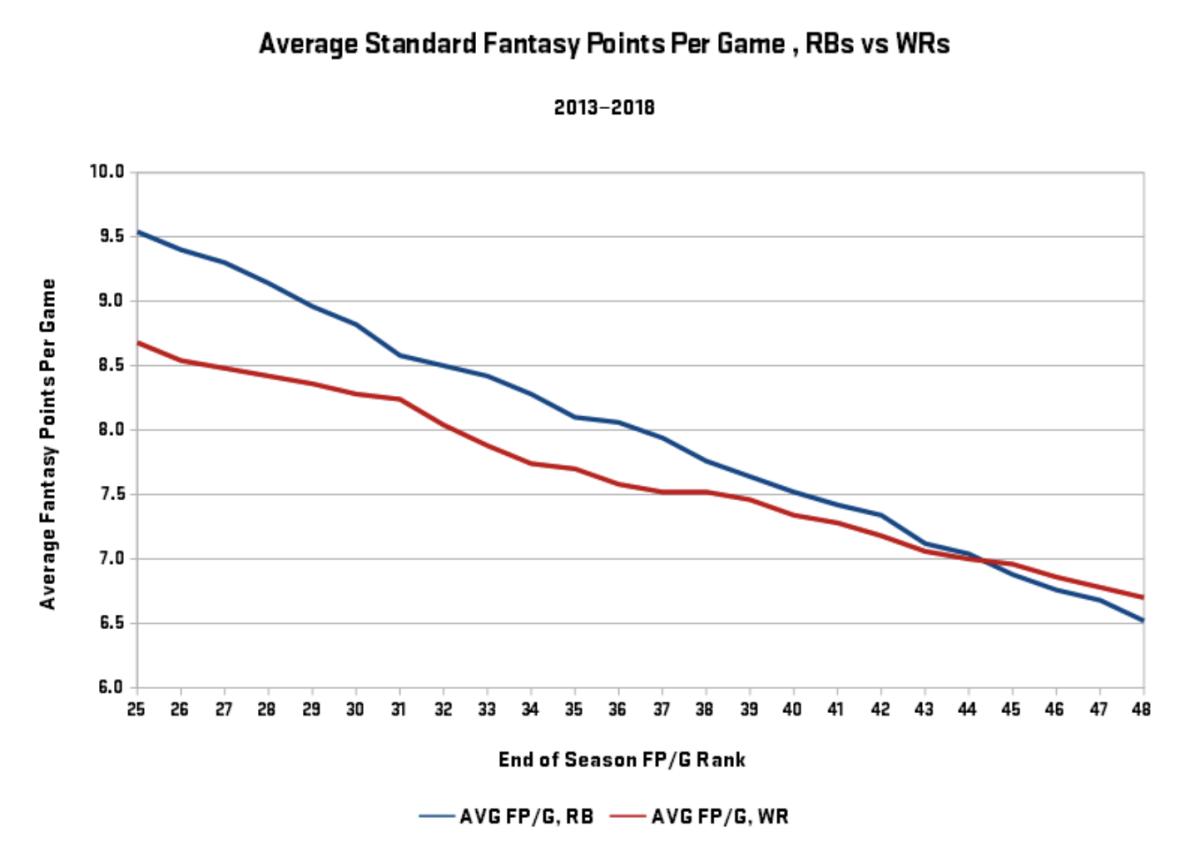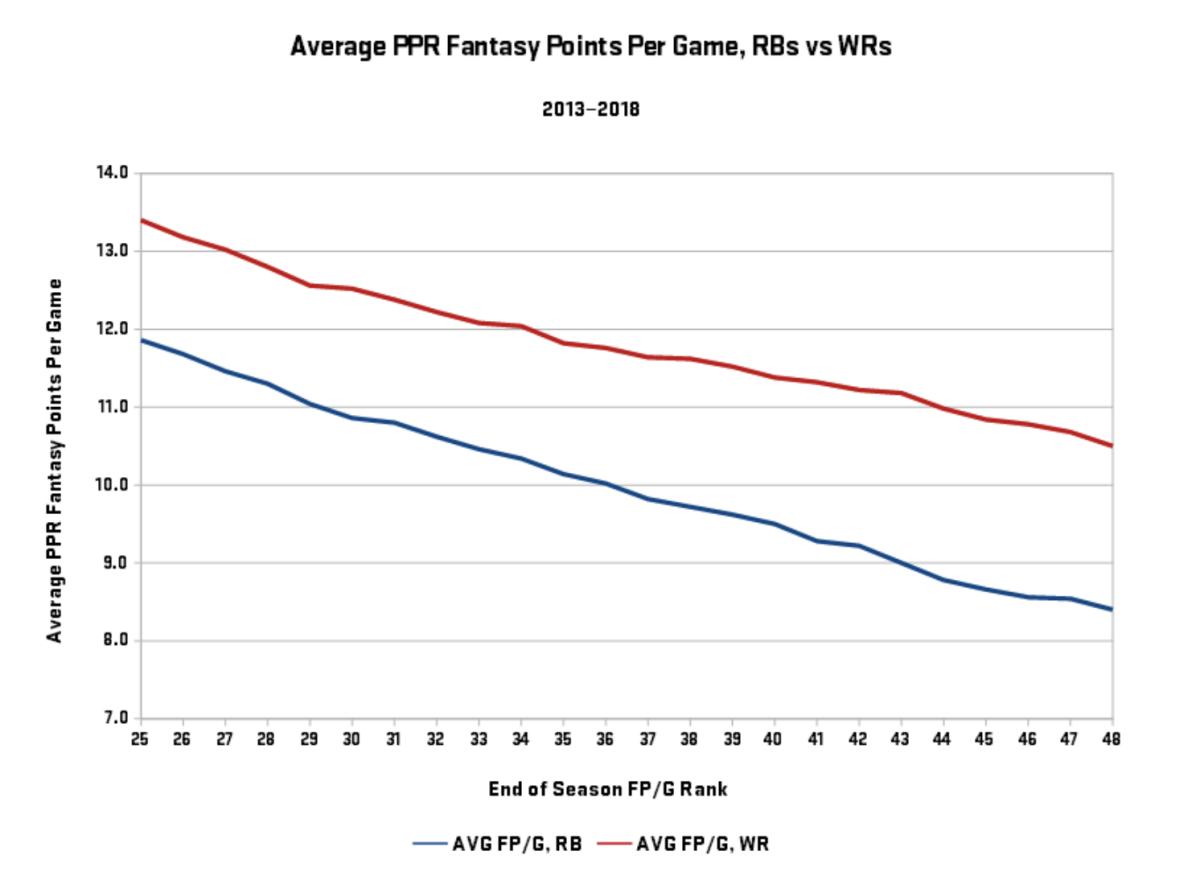How to Win the Flex Position in Fantasy Football

The flex position has become a bellwether of sorts in modern day fantasy football. Quite often, the teams that win the flex spot are those that compete for championships. The draft is a race to fill that flex spot in that it encourages owners to load up on wide receivers and running backs early and often (even if you can flex a tight end, it’s rarely a viable strategy). Once the season begins, deciding who to put in that flex position can be a weekly struggle, especially because it is so difficult to compare running backs and wide receivers in an apples-to-apples manner.
In almost every case of choosing your flex, using John Paulsen’s flex rankings at 4for4 will suffice—just plug in the higher ranked player. There are instances, though, where a running back and wide receiver are projected so closely together that deciding which one to plug into the flex can leave you pulling out your hair before kickoff.
Historical data can help point you in the right direction.

Standard Leagues
Unless you load up on one position early in your draft or are fortunate enough to have one of your late-round picks to rise to fantasy starter status, you’re usually choosing a flex from backs and receivers ranked in the 25-48 range at their respective positions. By using 4for4’s Fantasy Points Browser, we can see how, using end-of-season rankings, RB3s and RB4s have compared to WR3s and WR4s in recent standard scoring leagues.

On a per-game basis, running backs in the 25-48 range have scored slightly more than wide receivers in the same range in standard leagues. The margin has been so thin, though, that it’s worth comparing the positions at every individual ranking to look for more telling trends:

This visual representation highlights some interesting points to ponder when considering who to start in your flex spot in standard leagues. Running backs in the 25–30 range have scored notably more than wide receivers in the same range in recent years. On a weekly level, most NFL teams still have one NFL back that dominates touches, which explains why we see the gap in scoring in this range.
After the top 30 backs and receivers, scoring between the two positions starts to converge. Backs who aren’t seeing starter-level touches are less reliable, while more receivers have a chance to affect the game.
Consider the opportunity for playing time. In any given week, there are only 32 running backs who have a chance at playing the majority of their team’s offensive snaps, while there are conceivably 64 receivers who can play virtually every snap. That added playing time for lower-end receivers is highlighted in the graphic. Low-end WR4s score more than low-end RB4s, even in standard scoring. When a running back is that low in his team’s pecking order, there typically aren’t enough touches available to him a feasible starting option.
PPR Leagues
From 2013–2018, WR3s and WR4s have outscored running backs in the same range in PPR leagues. In fact, WR4s have scored more than RB3s in PPR formats over the last five seasons.

A glance at the individual end-of-season point-per-game rankings for the positions is even more telling:

In PPR leagues, mid-range receivers simply score more than running backs with a similar positional ranking. Targets and receptions are so valuable in PPR leagues that running backs who aren’t workhorses or heavily involved in the passing game are very difficult to justify as worthy starters in the flex spot.
Bottom Line
Running backs, even the ones ranked outside the top 24, who are heavily involved in their team’s game plan have value in standard leagues, and often outscore their wide receiver counterparts, although the scoring margin can be thin. Outside the top-30 backs, scoring between running backs and wide receivers is so close that the flex spot is usually a case-by-case decision. Once you start comparing low-end RB4s to low-end WR4s, wide receiver opportunity almost always bests that of running backs.
In PPR leagues, receivers dominate scoring. Filling the flex spot with a wideout who is a borderline starter can give you an advantage over your leaguemates every week.
No lineup decision should ever be made blindly in fantasy football, and that goes for choosing your flex. If you have a running back projected to outscore your receivers, he should fill your flex, even in PPR leagues. Historical trends can help shape our drafting tendencies and in-season roster management techniques, and those trends should be taken into account.
